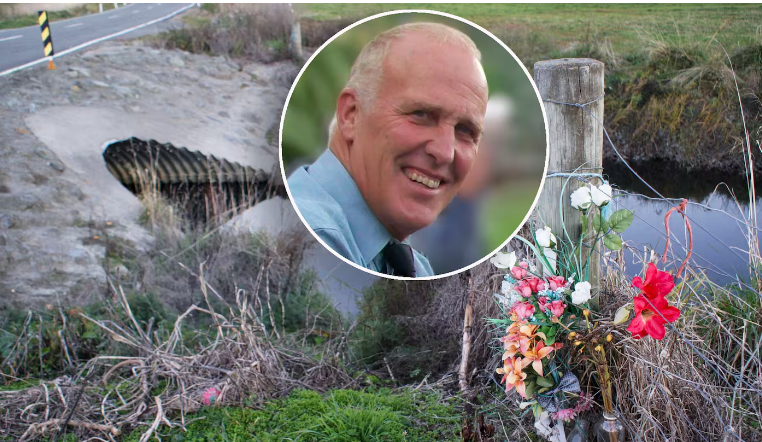Scratches on road were signs that Allister Christie’s car ‘ran over itself’ in high-speed impact

Flowers near a culvert beneath the road over the Ōpaoa River near Blenheim. Allister Christie (inset) died at this site in March 2022. Photo / NZME
Two sets of scratch marks on a road were signs Allister Christie’s car was “beginning to run itself over”.
The 70-year-old died after the high-speed crash while chasing the man he’d seen driving his Mercedes, stolen from outside his house the day before.
Despite the heavy impact, Christie was found in a postmortem not to have suffered serious injuries, but most likely died from being immersed in the river where both cars ended up.
Kyle James Clarke has admitted entering Christie’s Blenheim home on March 12, 2022, taking the keys and then taking the Mercedes but has denied charges linked to the circumstances in which Christie died the following day.
The 31-year-old is defending charges of reckless driving causing death, dangerous driving causing death (in the alternative) and failing to stop to ascertain injury or death at a judge-alone trial in the Blenheim District Court.
Crown prosecutor Jackson Webber said a primary trial issue was likely to be whether Clarke’s alleged high-speed and reckless driving caused Christie’s death.
The defence case is focused on causative events and the moments leading up to the collision and whether the cause of Christie’s tragic death was speed, which was “exponentially different in character” to his driving up to that point, lawyer Tony Bamford said.
The court heard on Monday from witnesses who saw the two cars travelling at speed through Blenheim streets before they ventured onto the highway in the minutes leading up to the crash in which Christie died.

Evidence yesterday from a serious crash investigator revealed in detail the seconds immediately after Christie’s silver SsangYong became airborne over a stop bank on a rural open road, nose-dived into the road and then smashed into the back of the Mercedes on the other side.
As Clarke drove over a stop bank before the river, described as a “blind hump” drivers were unable to see over until near the top, it’s alleged he then planned an evasive manoeuvre in the hope Christie would go past and not see him.
Moments later, Christie came over the stop bank at a speed estimated at more than 120km/h. His vehicle launched into the air and landed on its nose, skidded, and struck the rear of the blue Mercedes, pushing both vehicles into the Ōpaoa River where they were submerged.
The impact was so severe vehicle debris was scattered over a wide area, 51 metres from the top of the rise.
Blue paint from the Mercedes was found on the other side of a nearby bridge and engine parts were embedded in a concrete culvert where Christie’s Ssangyong ended up.
Police serious crash unit investigator Simon Burberry’s evidence revealed the scratch marks on the road were made by the Ssangyong’s collapsed front bumper as it “touched down”. A tyre mark further on was a sign of it being under “heavy load” and about to run off the rim.
“It was the car, beginning to run itself over,” he said.

Burberry said in answer to a question from the Crown that the driver’s seatbelt in Christie’s car was fully retracted but that was not evidence it wasn’t being worn.
Forensic pathologist, Dr Martin Sage said Christie did not have injuries that in themselves might have been fatal, and no seatbelt injury but that was not proof he was not wearing one.
He said the most likely scenario was that Christie had died from being immersed in water, with injuries that might have made it hard for him to get out. A contributing factor might have been the heart disease found post-mortem that Christie had not known about.
Dr Sage said it was feasible that in a highly charged situation, Christie could have died of a heart condition linked to the crash but that was unable to be tested.
He said it was unlikely to have occurred before he was submerged because the type of condition he had meant he would have been rendered unconscious within “seconds” had he gone into cardiac arrest.
The trial continues.
Tracy Neal is a Nelson-based Open Justice reporter at NZME. She was previously RNZ’s regional reporter in Nelson-Marlborough and has covered general news, including court and local government for the Nelson Mail.

